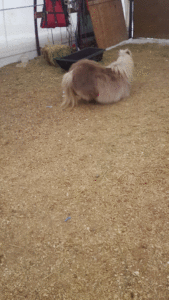With most of the continent “enjoying” a record breaking cold snap this month, I suspect there are a lot more horses spending time in stalls than usual.
Even here, where my horses live outdoors with run in sheds to protect them from the wind and extra hay on cold days to help keep them warm, I stall my three oldest at night in the winter, and when it’s really nasty out, they stay in during the day as well.
Stalling – especially when horses aren’t accustomed to it – coupled with the stress of a weather change, can add to the risk of colic or other gastrointestinal complications, such as ulcers.
What can you to to mitigate this risk, when you do want to stall you horses?
- Frequent small meals. This might mean keeping hay in front of them, possibly in a slow feed net. It might mean giving a snack at lunchtime and bedtime, in addition to usual feedings. My old folks get a little bit of extra senior feed at lunch time, when they’re in all day, and some hay at bed time – they don’t usually get hay at all, their dental issues make soaked cubes their usual forage ration, but a bit of hay keeps them busy and warmer on cold winter nights.
- Access to water. Horses need to have access to fresh, unfrozen water 100% of the time, especially when it’s cold. They might not be as inclined to drink during cold weather, so we need to make it as accessible to them as possible.
- Salt. Since horses don’t drink as well in cold weather, impaction colics are a real risk. By ensuring they have access to salt – or even by adding a teaspoon of salt to their feed – during periods of cold weather, you can encourage them to continue drinking and reduce the risk of colic.
- Movement matters. If your horse is being stalled for a prolonged time (more than just overnight) taking them for a walk or letting them out even for a few minutes can help them stretch their muscles. My barn is a tent building with a gravel floor (rubber mats under the stalls), and my old folks love to prance around and roll and roll and roll when I let them free range while I clean their stalls. Even Image, who is completely blind, loves to roll and then tuck himself back into his safe space.
- Blanketing. Horses in stalls are often even more likely to need blankets (unless, of course, you have a heated barn) than ones outside, as they’re not able to move around as much to warm up. Watch closely for any shivering and add a layer if needed.
- A Clean Bed. Stalls need to be cleaned at least daily, and if they’re in for 24 hours straight I usually pick a couple times a day and clean properly once. While I prefer shavings for ease of cleaning, straw is warmer.
- Friends. Even in their own stall, it’s important that your horses can see, and even touch, another horse, so they will feel safe. My stalls are mesh, so they’re able to see (or, in Image’s case, smell and touch) each other and know that they’re not alone. Isolation can be a very serious cause of stress for horses.
What other tools to you use to help your horses adapt when they have to be stalled?

Some horses like to play with stall toys.